List of Contents
What is the Soil Monitoring Market Size?
The global soil monitoring market size is accounted at USD 900.01 billion in 2025 and predicted to increase from USD 1,039.24 billion in 2026 to approximately USD 3,284.50 billion by 2034, expanding at a CAGR of 15.47% from 2025 to 2034. The soil monitoring market is driven by growing demand for precision farming, adoption of smart soil sensing technologies, and continuous investment in research and development.
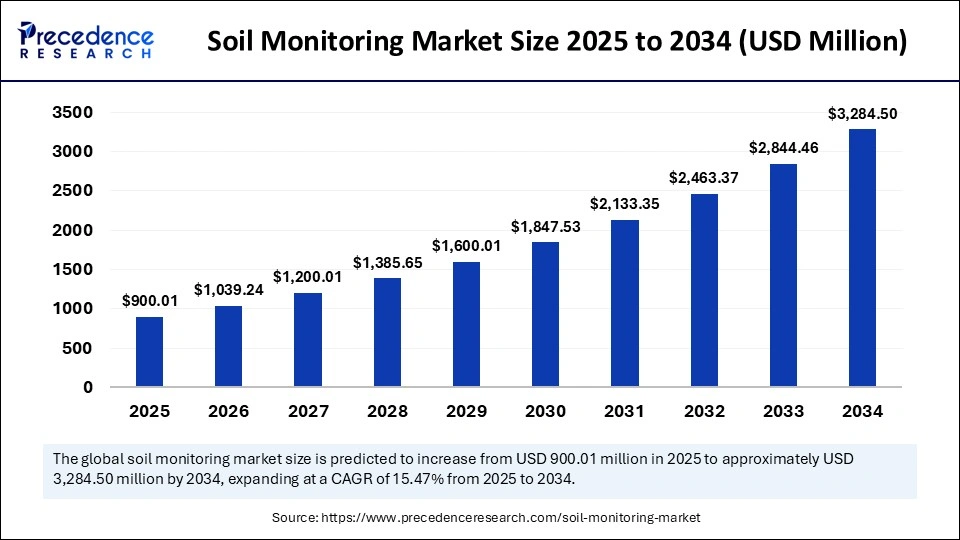
Soil Monitoring Market Key Takeaways
- North America dominated the global market by holding more than 37% of revenue share in 2024.
- Europe is expected to grow at a notable CAGR of 15.5% during the forecasted years.
- By offering, the hardware segment held the biggest revenue share of 47% in 2024.
- By offering, the software segment is anticipated to show considerable growth in the market over the forecast period.
- By type, the ground-based sensing segment contributed the highest revenue share of 49% in 2024.
- By type, the robotic & telematics segment is anticipated to show considerable growth in the market over the forecast period.
- By application, the agricultural segment accounted for the highest revenue share of 75% in 2024.
- By application, the non-agricultural segment is anticipated to show considerable growth in the market over the forecast period.
Artificial Intelligence: The Next Growth Catalyst in Soil Monitoring
Artificial Intelligence helps farmers increase their farms' productivity and makes farming more certain. These technologies improve the quality of what is produced and also cut down on wasting resources. Farmers can handle irrigation and fertilizer application more efficiently due to new AI technologies. The increased focus on the global environment has enabled the automated systems to be more valued as accurate soil analysis performed by AI precision enhances environmental stewardship. Advanced farm technologies also lead to the use of less water and chemicals, thus protecting the environment.
Strategic Overview of the Global Soil Monitoring Industry
Soil monitoring examines soil characteristics, structure, and the properties of soil in a way to assess viability for crops and to ensure healthy environments. It is useful to find hazards in soil (contaminated soils, compacted soils, salinized soils, or organic matter breakdown). Sensors can be employed at various depths and locations to get a complete perspective of how healthy the soil is. There is a gradual increase in sensor technology in sectors such as agriculture, ecology, meteorology, and land management. The focus of governments around the world on sustainable soil health, by using monitoring technology, governments can promote healthy, sustainable farming, especially long-term viability.
The increase in global population creates a higher demand for improved agricultural production, and that drives the soil monitoring market. These systems provide farmers with the opportunity to make the most effective possible decisions for more agricultural production using fewer inputs. With technological advances, soil sensors are cheaper, more reliable, and more durable, creating opportunities for more users to use these sensors. Support from the government in agricultural research and development encourages more use of modern farming methods and leads to a larger market. With growing issues of climate change and damaged soil, monitoring the soil becomes even more important for both food safety and the environment.
What Are the Growth Factors Driving the Soil Monitoring Market?
- Increasing The Need For Agricultural Productivity: With soil monitoring, farmers can closely scan the fields, leading to an increase in water and fertilizer efficiency, which ultimately improves the harvest yields. Smart farming's rising applicability and requirement are further broadening the market.
- Technology Advancements with Sensors: The introduction of low-cost, quality soil sensors has made soil monitoring easier and more accurate. Current sensors can test the soil from multiple depths, which makes the data more useful. Since the tools have emerged, there is a growing trend among farmers and researchers toward the use of monitoring systems.
- Government Policy Changes as well as R&D Funding: Pharmaceuticals base a large chunk of their spending on agriculture policies, providing farmers with subsidies which are aimed at revitalizing interest revitalization using modern techniques. This enables countries to easily adapt to soil monitoring systems and especially benefitting those countries where agriculture is the mainstay.
- Growing Adoption of Precision Agriculture: Precision agriculture uses information and technology to help farmers farm more efficiently and get bigger harvests. As farmers are using more precise farming tools, they also need more tools and technology to watch over the health of their soil.
Market Outlook
- Market Growth Overview: The Soil Monitoring market is expected to grow significantly between 2025 and 2034, driven by rising adoption of IoT-enabled sensors, AI-driven analytics, cloud-based platforms, precision agriculture, and a shift in connectivity.
- Sustainability Trends: Sustainability trends involve focus on soil health and organic matter, precision agriculture & resource optimization, and climate-resilient farming and carbon sequestration.
- Major Investors: Major investors in the market include Venture Capital (VC) Firms. Omnivore VC, NABVENTURES, Accel, Elevation Capital, and Prosus Ventures.
- Startup Economy: The startup economy is focused on accessible soil analytics, carbon farming and credits, and biofertilizers and soil health.
Market Scope
| Report Coverage | Details |
| Market Size by 2034 | USD 3,284.50 Million |
| Market Size in 2025 | USD 900.01 Million |
| Market Size in 2026 | USD 1,039.24 Million |
| Market Growth Rate from 2025 to 2034 | CAGR of 15.47% |
| Dominating Region | North America |
| Fastest Growing Region | Europe |
| Base Year | 2024 |
| Forecast Period | 2025 to 2034 |
| Segments Covered | Offering, Type, Application and Regions |
| Regions Covered | North America, Europe, Asia-Pacific, Latin America, and Middle East & Africa |
Market Dynamics
Driver
Growing initiatives to advance agriculture practices
Improving farming practices are responsible for mainly driving the expansion of the soil monitoring market. With soil monitoring systems, farmers receive quick and continuous data about soil conditions, which allows them to decide what is needed to improve their harvest and the use of resources. Many governments and private businesses around the world are offering support and funding to make farming sustainable.
They usually involve discounted equipment for smart farming and funding for improvement in agricultural technology. Strong environmental rules and people's increased awareness about soil health have also added to the increase in demand. Soil monitoring equipment is important in farms to ensure the soil is healthy for years to come.
Restraint
High initial investment
The high cost of installing soil monitoring systems continues to stop many small and medium-sized farms from adopting them. Operating these systems continues to cost money through regular maintenance, calibration, and infrequent software updates. It can be challenging for farmers who are not technicians to handle and make sense of large data from soil. For farm management devices, more soil data is needed, and this is difficult to accomplish without digital infrastructure in rural areas. Along with significant financial and technical barriers, the adoption of the monitoring systems could improve soil productivity, sustainable agriculture, and lifelong soil stewardship.
Opportunity
Integration with Sustainable Farming Practices
Soil monitoring technology can significantly assist in the growth of the sustainable agriculture market. If more people turn to sustainable agriculture, the technology being adopted will be more effective and environmentally friendly. In this regard, soil monitoring supports environmentally sustainable agriculture through the real-time access to soil health, moisture, and nutrient data. With this knowledge, farmers decide how to use chemicals in a way that protects both the soil and water supply. Moreover, people who care about the environment are contributing to the use of sustainable farming, making these systems even more popular. When governments and firms push for more sustainable agriculture, eco-friendly initiatives tend to grow quicker.
Offering Insights
The hardware segment led the soil monitoring market and accounted for the largest revenue share in 2024. A rise in the number of soil detection and monitoring systems, such as soil detectors, soil scanners, and meteorological stations, has helped to drive up the segment's popularity. They accurately measure several soil parameters, which makes them necessary for any type of soil monitoring system. Those farmers who adopt new agricultural practices are spending more on top-grade soil monitors, as their usefulness for better crop results and managing the farm has been proven.
Combining farm equipment with precision farming methods also helps provide accurate real-time data useful for making better decisions. As people become more aware of sustainable farming, the accurate soil data is needed more.
The software segment is expected to grow at a significant CAGR over the forecast period. This is happening as more farms integrate with systems that manage all aspects of farm operations. The data from sensors is turned into useful information to guide farmers about irrigation, fertilization, and planning their crops. With farming going digital, the need for tools that gather information on soil, weather, machines, crops, and finances is increasing. The ability to link with precision farming equipment, systems for irrigation, and predicting harvest added value makes soil monitoring software a key element of digital farming. Using cloud-based software provides access to data whenever needed and helps with overseeing farms from a distance, perfect for extensive farming businesses.
Type Insights
The ground-based sensing segment contributed for the largest share of 49% in 2024 and is expected to dominate throughout the projected period. By embedding sensors in the soil, ground-based sensors record moisture, temperature, pH, and plant nutrient data accurately. Through this data, farmers can have variable treatments of crops that produce improved yields and conserve resources. Because precision agriculture is being emphasized across the globe, the demand for constant soil data is also rising and leading to an increase in ground-based systems.
The small and medium-sized farms prefer ground-based sensors over complicated sensors because installing them requires less effort and costs less. Growers will increasingly rely on soil monitoring to better manage their soil as more people want sustainable farming.
The robotic & telematics segment is expected to grow substantially in the Soil monitoring market. Soil sensors and wireless telematics are mounted on automation-ready robots to help collect, transfer, and analyze information immediately from the fields. The use of robots in farming makes things run more smoothly, since they can collect soil data automatically, help cut down on the workforce needed, and make it possible to check fields more often over a wide area.
Telematics further helps by sending notifications and useful information right away to the main control system, which makes it quicker to react and lets managers make smart decisions based on the data. Since the climate is becoming less predictable and disrupts crops and soil, integrating robotic and telematics technology in soil monitoring is an effective way to manage such challenges.
Application Insights
The agricultural segment captured the major revenue share of 75% in 2024. Soil sensors placed near the roots allow for better scheduling of irrigation and give crops the correct amount they need. It leads to better farming yields, uses less energy and fertilizer, helps protect the local environment from runoff, and boosts the profit margin of farms. Also, with Agriculture IoT, there are more chances for farmers since data about the soil can be measured in real-time, combined with farm management tools, and automated tasks can take place.
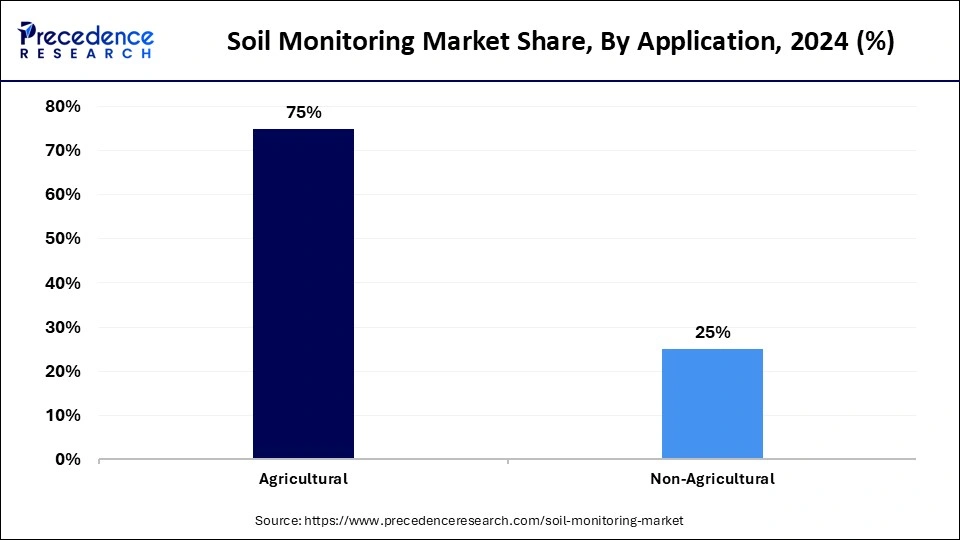
The non-agricultural segment is expected to grow substantially in the Soil monitoring market. The use of sophisticated soil monitoring systems is rising in golf courses, sports grounds, landscaped areas, places in the forestry industry, and residential areas to help maintain and irrigate the entire area better. They allow you to save water and money on upkeep, all the while ensuring the landscape is sustainable. Soil monitoring is regularly adopted by industrial companies for real-time environmental impact assessment and control. Pressure from chemical manufacturing, mining, and waste disposal makes it necessary that soil contamination assessment takes place for broader implications for nature and human health.
Regional Insights
U.S. Soil Monitoring Market Size and Growth 2025 to 2034
The U.S. soil monitoring market size was exhibited at USD 249.75 million in 2025 and is projected to be worth around USD 929.92 million by 2034, growing at a CAGR of 15.70% from 2025 to 2034.
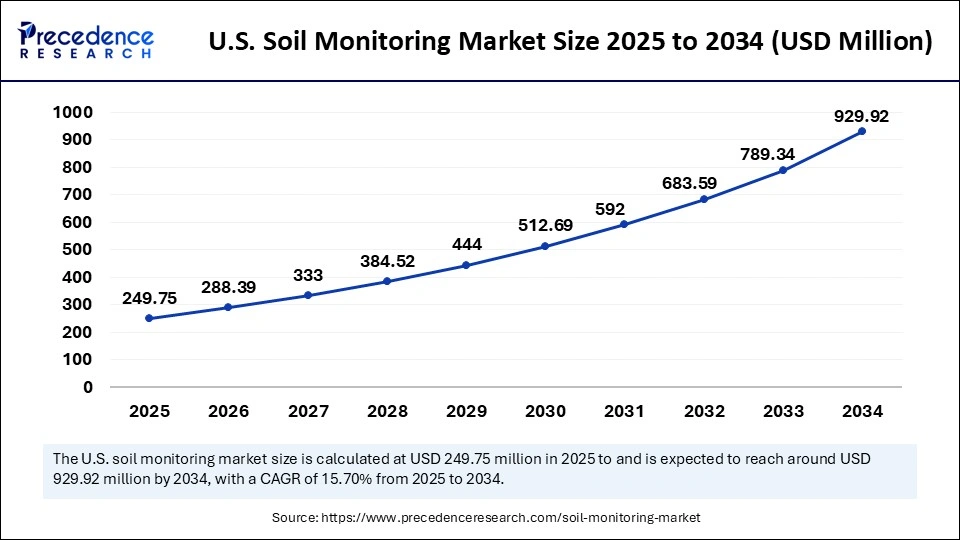
What Factors Led to North America's Leadership in the Soil Monitoring Market in 2024?
North America accounted for the major market share of 37% in 2024. The use of smart soil monitoring tools, like sensing and imaging devices, is mainly responsible for the growth. Larger businesses joining the market and continuous investment in precision agriculture push the global market to grow. The well-established farming industry and focus on sustainability, many farms in the region use soil monitoring systems.
Canada and the United States are at the forefront of the North American soil monitoring market because of their quick adoption of smart farming, and have a well-developed agricultural community. Furthermore, the area's advanced R&D allows for regular enhancements in tools used for soil monitoring. The combination of these conditions places North America in the forefront for advancing and growing soil monitoring technology.
U.S. Soil Monitoring Market Trends
The U.S. market is rapidly growing as farmers increasingly adopt precision agriculture technologies to optimize water and nutrient use. AI powered IoT soil sensors now enable real time data collection on moisture, pH, and nutrient levels, helping drive smarter agronomic decisions. There's rising demand for sustainable farming solutions, backed by government conservation initiatives and climate resilience programs.
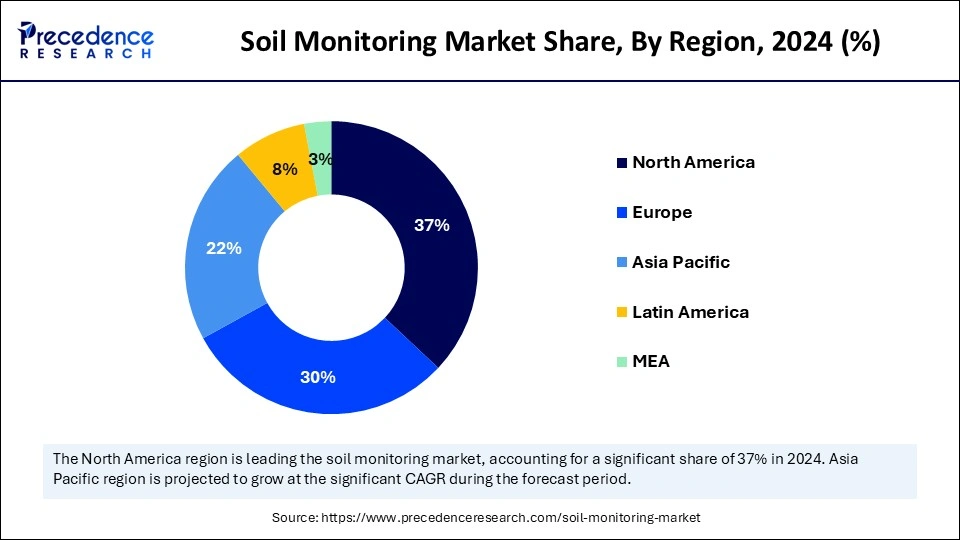
Why Is Europe Experiencing Rapid Growth in the Soil Monitoring Market?
The Europe region is anticipated to witness the highest growth rate during the forecast period. Precision farming is commonly used in agriculture in Europe because it requires reliable information regarding the functioning of soil to produce and manage crops and soils. Where soil and sustainability are of great importance, soil monitoring systems are being used by more people in Europe.
Germany Soil Monitoring Market Trends
Germany is leading the way on soil monitoring systems, aided by some government support and an increase in knowledge of precision agriculture among farmers. In addition to agriculture, there are industries such as construction, meteorology, mining, forestry, and watershed management that also use soil monitoring tools. All of these different uses promote faster development and new arrangements throughout Europe.
- In July 2023, the European Union launched a Soil Monitoring Law, which aims to set a common approach for restoring healthy soil within the Union. Countries are required by law to check soil health similarly and collect data on it. The ambition is to remediate all European Union soils to a healthy state by 2050.
(Soruce: https://environment.ec.europa.eu)
Asia Pacific Soil Monitoring Market Trends
Asia Pacific also emerged as a significant market for soil monitoring, accounting for a substantial market share in 2024 due to the widespread installation of ground-based sensors and cameras that help improve plant growth. China is the major player in the soil monitoring market, and because of the government's increasing support through policies, investments, and favorable acts for farming.
India is expected to grow at a fast pace. Because this region prioritizes sustainable and precise farming and wants to grow more crops, monitoring the soil is becoming more popular. The government's efforts in digital agriculture and technology are driving more growth in the market.
- In August 2024, the Krishi-DSS geo-spatial tool was revealed to give users up-to-date information on weather, soil, crop health, acreage, and advisory services.(Source: https://www.pib.gov.in)
Value Chain Analysis of the Soil Monitoring Market
- Hardware & Sensor Manufacturing
This stage is the foundation of soil monitoring, involving the production of physical devices like soil moisture, nutrient, pH, and temperature sensors, as well as data loggers and weather stations.
Key Players: METER Group, Campbell Scientific, Sentek Technologies, Stevens Water Monitoring Systems, and the - Irrometer Company.
Software Development & Data Analytics
Raw data collected from sensors is transformed into actionable insights, visualizations, and recommendations using sophisticated software, cloud platforms, and analytics.
Key Players: CropX Technologies, The Toro Company (with its partnership with TerraRad), Trimble Inc., and Yara International. - System Integration & Distribution
This stage involves the integration of various hardware and software components into a comprehensive and often customized solution for end-users, along with establishing distribution networks.
Key Players: SGS Group and The Toro Company. - Service Provision & Consultation
Beyond providing the technology, companies offer services such as soil testing, consultation, installation, maintenance, and ongoing data monitoring as a service. Key Players: SGS Group
Recent Developments
- In February 2025, With TerraRad, Toro Company shared a new software tool for reliable irrigation management. Spatial Adjust is a new product made for Toro Lynx Central Control that seeks to bring major improvements to irrigation management. The software works with TerraRad's turfRad smart sensors on Toro equipment to measure soil moisture as the mower runs.
- In May 2024, Stevens Water Monitoring Systems, Inc. purchased the weather instruments from Dyacon. As a result of this deal, Stevens' range of meteorological services now includes solving weather-related needs in research, sports turf management, monitoring climate, soil analysis, agriculture, fire weather, and emerging small airport markets.
- In February 2024, CropX Technologies collaborated with Syngenta to help Syngenta's seed suppliers accomplish better sustainability and yield results in the Midwest. Data collected by the CropX agronomics comes from soil sensors as well as farming equipment used on the field.(Source: https://newsroom.toro.com)
(Source: https://stevenswater.com)
(Source:https://cropx.com)
Top Companies in the Soil Monitoring Market & Their Offerings:
- Campbell Scientific contributes significantly to the soil monitoring market by manufacturing rugged, reliable data acquisition systems and a variety of sensors for research-grade environmental measurement. These systems are used to monitor soil moisture, temperature, and nutrient levels in demanding conditions for research, agricultural, and industrial applications.
- CropX Technologies is a leading ag-tech contributor, providing an integrated hardware and software solution that includes soil sensors and a cloud-based platform for data analytics and irrigation recommendations. Their technology helps farmers optimize water usage and nutrient management, contributing to both sustainability and increased crop yields.
- Element Materials Technology contributes to the soil monitoring market primarily through its comprehensive environmental testing services. They provide crucial laboratory analysis of soil samples for a wide range of contaminants and physical properties, supporting environmental compliance and land remediation projects.
Irrometer Company, Inc. contributes to the soil monitoring market as a long-standing provider of soil moisture measurement devices, particularly tensiometers. Their products offer simple yet effective tools for determining when to irrigate, helping in efficient water management in agriculture and landscaping. - METER Group is a major contributor, offering a wide array of high-quality sensors and data acquisition systems used for measuring soil moisture, water potential, temperature, and heat flux. Their technology is widely used in both agricultural and scientific research due to its precision and reliability in field conditions.
- SGS Group contributes to the soil monitoring market through its extensive range of inspection, testing, and certification services, including detailed soil analysis for a variety of purposes. They provide essential third-party verification of soil health, contamination levels, and nutrient content, which is vital for agriculture, construction, and environmental compliance.
- Sentek Technologies contributes to the market as a global leader in manufacturing soil moisture and salinity monitoring probes, providing continuous data from multiple soil depths. Their solutions offer precise insights into root zone conditions, enabling farmers to make informed decisions to improve irrigation efficiency and crop performance.
- Spectrum Technologies contributes to the soil monitoring market by providing a range of affordable and user-friendly products for agricultural and turf uses, including soil moisture and nutrient meters. Their tools focus on simplifying field measurements and helping growers make timely decisions regarding irrigation and fertilization practices.
- Stevens Water Monitoring Systems, Inc. contributes to the soil monitoring market by manufacturing a variety of sensors and integrated solutions for environmental and agricultural monitoring. Their products are used for continuous measurement of soil moisture and other parameters, offering reliable data for water resource management and research.
- The Toro Company primarily contributes through its irrigation solutions division, offering technologies and products that help in managing water usage efficiently.
Soil Monitoring Market Companies
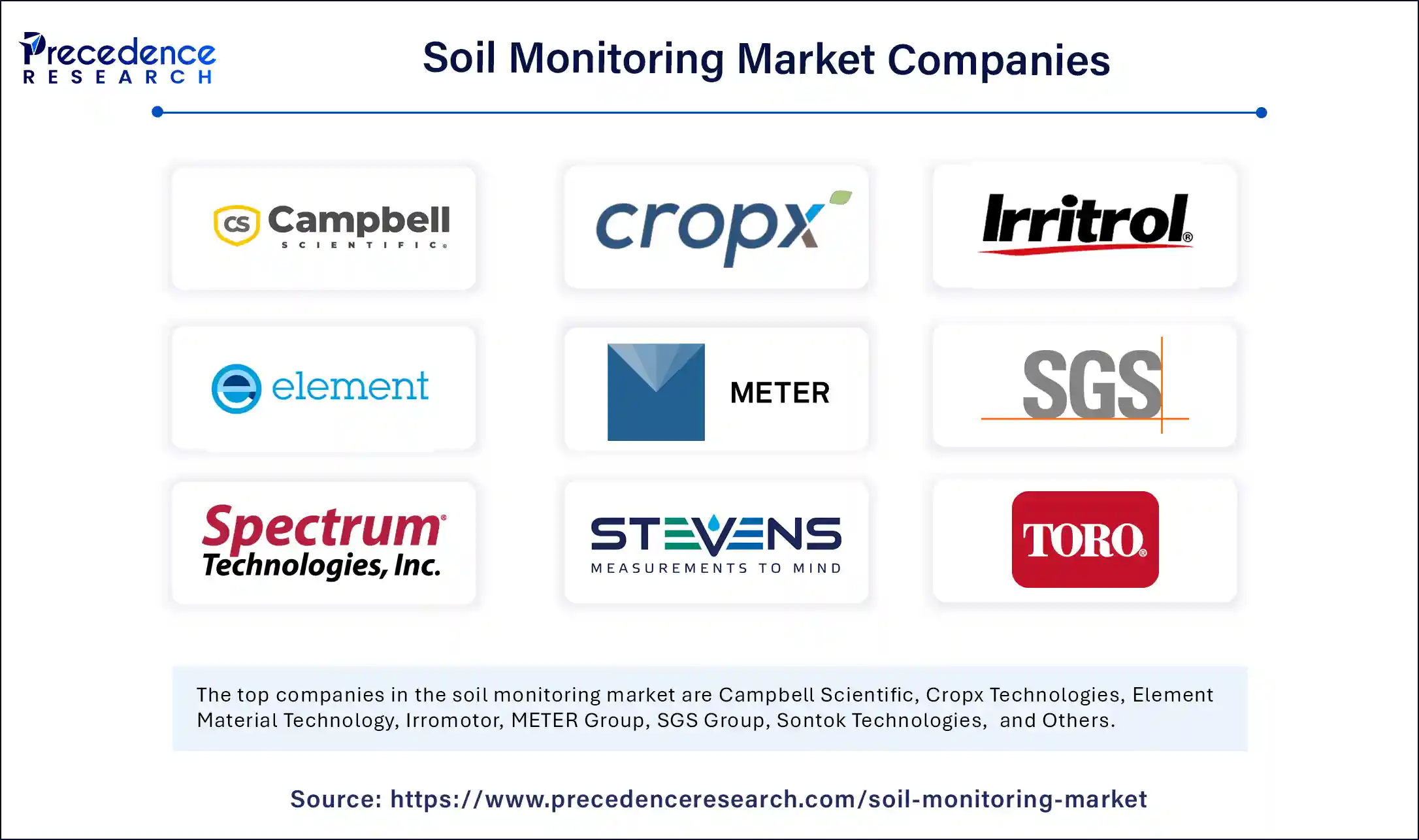
- Campbell Scientific
- Cropx Technologies
- Element Material Technology
- Irromotor
- METER Group
- SGS Group
- Sontok Technologies
- Spectrum Technologies
- Stevens Water Monitoring Systems
- The Toro Company
Segments Covered in the Report
By Offering
- Hardware
- Software
- Services
By Type
- Sensing & imagery
- Ground-based sensing
- Robotic & telematics
By Application
- Agricultural
- Non-agricultural
By Region
- North America
- Asia Pacific
- Europe
- Latin America
- Middle East & Africa
For inquiries regarding discounts, bulk purchases, or customization requests, please contact us at sales@precedenceresearch.com
Frequently Asked Questions
Ask For Sample
No cookie-cutter, only authentic analysis – take the 1st step to become a Precedence Research client